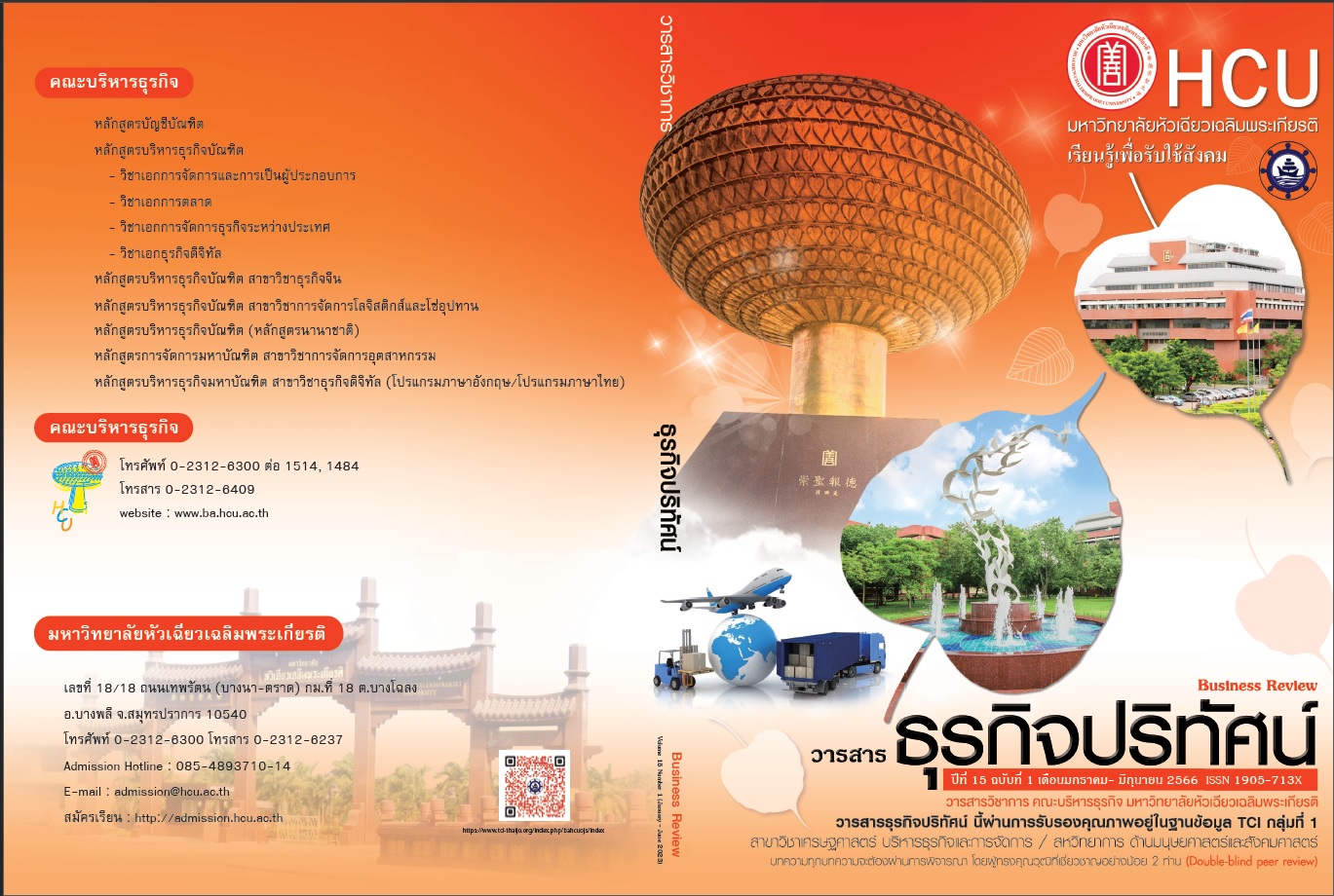ปัจจัยอุปทานในที่พักแรมที่สัมพันธ์กับประเด็นการบอกต่อทางลบ
关键词:
พักแรมในประเทศไทย , ความไม่พอใจ , อุปทาน, ความคิดเห็นออนไลน์摘要
การวิจัยครั้งนี้มีวัตถุประสงค์เพื่อศึกษาความสัมพันธ์ระหว่างลักษณะของอุปทาน (ระดับดาว ที่ตั้ง ขนาดของที่พัก ระดับราคาของที่พัก และระบบการบริหาร) กับประเด็นการบอกต่อทางลบที่พักแรมของประเทศไทยบนเว็บไซต์สำรองที่พักออนไลน์ เป็นการวิจัยผสมผสาน ซึ่งวิธีการวิจัยเชิงคุณภาพ ใช้การสำรวจข้อความแสดงความคิดเห็นเชิงลบบนเว็บไซต์สำรองที่พักออนไลน์ โดยใช้เกณฑ์ในการการคัดเลือกทั้งสิ้น 3 เกณฑ์ คือ เกณฑ์การคัดเลือกเว็บไซต์สำหรับเก็บข้อมูล เกณฑ์การคัดเลือกที่พักแรมสำหรับเก็บข้อมูล เกณฑ์การคัดเลือกความคิดเห็นทางลบ ตามลำดับ ซึ่งได้จำนวน 3713 ข้อความ และนำมาจำแนกตามส่วนประสมการตลาดบริการ วิธีการวิจัยเชิงปริมาณ ทำการทดสอบสมมติฐานด้วยสถิติ Chi-Square และค่าขนาดผลความสัมพันธ์สัมประสิทธิ์คราเมอร์สวี พบว่า ระดับดาว ทำเล ขนาดที่พัก และระดับราคาของที่พักมีความสัมพันธ์กับประเด็นการบอกต่อทางลบอย่างมีนัยสำคัญทางสถิติที่ 0.05 นอกจากนี้ ระดับดาว ทำเล ขนาดของที่พัก และระดับราคาของ ที่พัก มีความสัมพันธ์กับประเด็นการบอกต่อทางลบในระดับน้อยถึงน้อยมาก
参考
กฤษณะ ดาราเรือง, สิทธิพร เขาอุ่น และเชาฤทธิ์ จงเกษกรณ์ . (2561). การรับรู้คุณภาพการให้บริการและส่วนประสมการตลาดที่ส่งผลต่อความภักดีของผู้ใช้บริการโรงแรมในอำเภอเมืองนครสวรรค์ จังหวัดนครสวรรค์. วารสารวิทยาลัยดุสิตธานี, 2(ฉบับพิเศษ), 57-70.
ชัยณรงค์ พิพิธวีรนันท์. (2559). ปัจจัยส่วนผสมทางการตลาดและพฤติกรรมของนักท่องเที่ยวชาวไทยที่เลือกใช้บริการที่พักประเภทโฮสเทล ในเขตจังหวัดประจวบคีรีขันธ์. วิทยานิพนธ์บริหารธุรกิจมหาบัณฑิต, มหาวิทยาลัยนานาชาติแสตมฟอร์ด.
เตือนใจ ศรีชะฏา. (2560). ปัจจัยที่ส่งผลต่อการตัดสินใจเลือกที่พักแรมของนักท่องเที่ยวชาวไทยในเขตพื้นที่เมืองพัทยา. วารสารวิจัยและพัฒนา วไลยอลงกรณ์ ในพระบรมราชูปถัมภ์ สาขามนุษยศาสตร์และสังคมศาสตร์, 12(1), 247-259.
Ali, R. (2014). The most popular online booking sites in travel, 2014 edition. Retrieved April 26, 2017, website: https://skift.com/2014/06/17/the-most-popular-online-booking-sites-in-travel-2014-edition/
Ariffin, A., & Maghzi, A. (2012). A preliminary study on customer expectations of hotel hospitality: Influences of personal and hotel factors. International Journal of Hospitality, 30(1), 191-198.
Ascaniis S.D., Borrè A., Marchiori E., & Cantoni L. (2015) listen to your customers! How hotels manage online travel reviews. The case of hotels in lugano. In: tussyadiah i., inversini a. (eds), Information and Communication Technologies in Tourism 2015., Switzerland : Springer.
Bona, K., Seongseop, K., & Heo, C. Y. (2019). Consequences of customer dissatisfaction in upscale and budget hotels: focusing on dissatisfied customers’ attitude toward a hotel. International Journal of Hospitality & Tourism Administration, 20(1), 15-46.
Cakim, I. M. (2010). Implementing Word of Mouth marketing: online strategies to identify influncers, craft stories, and draw customers. New Yersey: John Wiley & Sons.
Dolnicar, S. (2007). Business travellers’ hotel expectations and disappointments: A different perspective to hotel attribute importance investigation. Asia Pacific Journal of Tourism Research, 7(1), 29-35.
Euromonitor International. (2017). Top 100 city destinations ranking: wtm london 2017 edition. London: Euromonitor International.
Frye, W. D., & Mount, D. J. (2007). An examination of job satisfaction of general managers based on hotel size and service type. Journal of Human Resources in Hospitality & Tourism, 6(2), 109-134.
Jeong, M., & Jeon, M. M. (2008). Customer reviews of hotel experiences through consumer generated media (cgm). Journal of Hospitality & Leisure Marketing, 17(1), 121-138.
Katay, A. (2015). The causes and behavior-altering effects of hotel guests’ dissatisfaction. Journal of Tourism & Services, 6(11), 28.
Knutson, B. (1988). Frequent travelers: making them happy and bringing them back. The Cornell Hotel and Restaurant Administration Quarterly, 29(1), 82-87.
Lee, J., Park, D.H., & Han, I. (2008). The effect of negative online consumer reviews on product attitude: An information processing view. Electronic Commerce Research and Applications, 7(3), 341-352.
Lee, S. K., & Jang, S. S. (2011). Room rates of u.s. Airport hotels : examining the dual effects of proximities. Journal of travel Research, 50(2), 186-197.
Litvin, S. W., Goldsmith, R. E., & Pan, B. (2008). Electronic word-of-mouth in hospitality and tourism management. Tourism management, 29(3), 458-468.
Mariussen, A., Brookes, M., Bowie, D., & Buttle, F. (2016). Hospitality marketing. London: Taylor & Francis Ltd.
Middleton, V., & Clarke, J. (2001). Marketing in travel and tourism. Boston: Butterworth-Heinemann.
Ottenbacher, M., Shaw, V., & Lockwood, A. (2006). An investigation of the factors affecting innovation performance in chain and independent hotels. Journal of Quality Assurance in Hospitality & Tourism, 3(4), 113-128.
Porter, W. L., & Lawyer, E. E. (1965). Properties of organization structure in relation to job attitudes and job behavior. Psychological Bulletin, 64(1), 23-51.
Ruekert, R., Walker, O.J., & Roering, K. (1985). The organization of marketing activities: a contingency theory of structure and performance. Journal of Marketing, 49(1), 13-25.
Sparks, B. A., & Browning, V. (2011). The impact of online reviews on hotel booking intentions and perception of trust. Tourism Management, 32(6), 1310-1323.
Va´squez, C. (2011). Complaints online: the case of tripadvisor. Journal of Pragmatics, 43(6), 1707-1717.
Yang, Y., Mao, Z., & Jingyin, T. (2017). Understanding guest satisfaction with urban hotel location. Journal of Travel Research, 57(2), 243-259.
##submission.downloads##
已出版
##submission.howToCite##
期
栏目
##submission.license##
##submission.copyrightStatement##
##submission.license.cc.by-nc-nd4.footer##บทความที่ได้รับการตีพิมพ์เป็นลิขสิทธิ์ของวารสารธุรกิจปริทัศน์
ข้อความที่ปรากฏในบทความแต่ละเรื่องในวารสารวิชาการเล่มนี้เป็นความคิดเห็นส่วนตัวของผู้เขียนแต่ละท่านไม่เกี่ยวข้องกับมหาวิทยาลัยหัวเฉียวเฉลิมพระเกียรติ และคณาจารย์ท่านอื่น ๆ ในมหาวิทยาลัยฯ แต่อย่างใด ความรับผิดชอบองค์ประกอบทั้งหมดของบทความแต่ละเรื่องเป็นของผู้เขียนแต่ละท่าน หากมีความผิดพลาดใดๆ ผู้เขียนแต่ละท่านจะรับผิดชอบบทความของตนเองแต่ผู้เดียว




